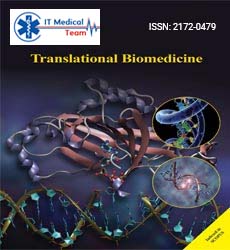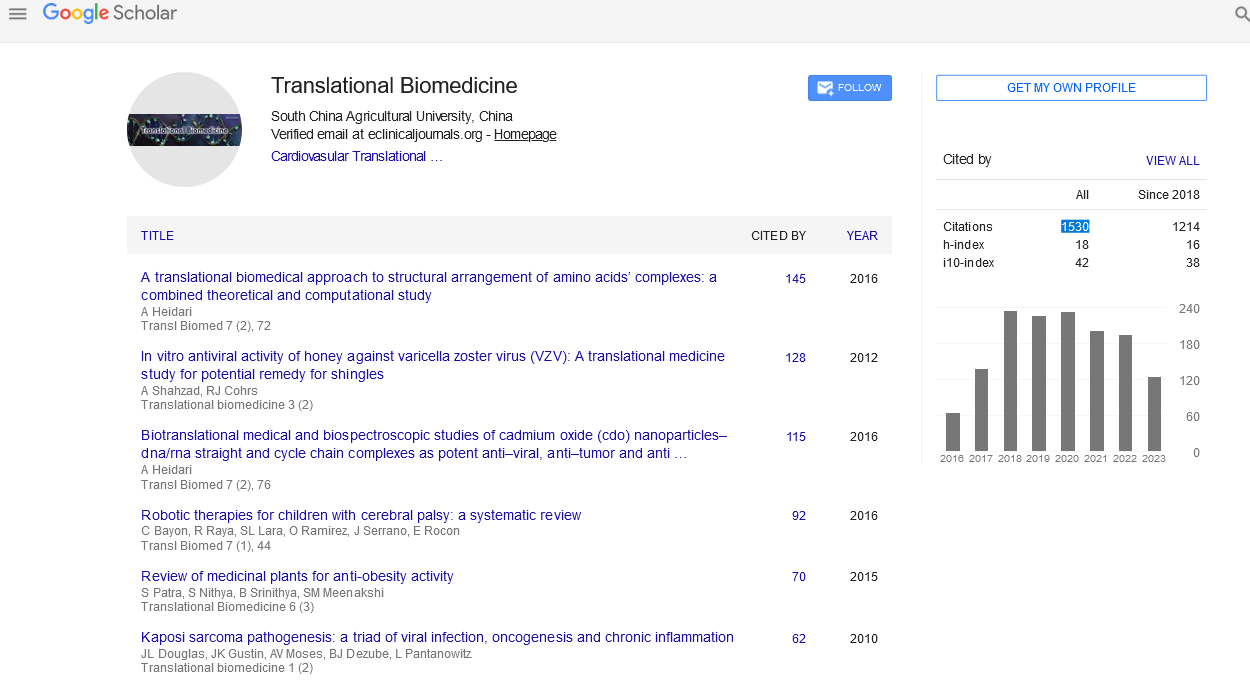Review Article - (2023) Volume 14, Issue 3
Using tissue culture and Biotechnology in manufacturing Coronary Stents to reduce late complications
N John Camm*
Klinikum Nurnberg Hospital, Germany
*Correspondence:
N John Camm, Klinikum Nurnberg Hospital,
Germany,
Tel: +49 32211226465,
Email:
Received: 01-Mar-2023, Manuscript No. Iptb-23-13526;
Editor assigned: 03-Mar-2023, Pre QC No. Iptb-23-13526 (PQ);
Reviewed: 16-Mar-2023, QC No. Iptb-23-13526;
Revised: 20-Mar-2023, Manuscript No. Iptb-23-13526 (R);
Published:
27-Mar-2023, DOI: 10.36648/2172- 0479.14.3.286
Abstract
The use of tissue culture and biotechnology in manufacturing coronary stents has shown potential in reducing late complications. The development of biodegradable stents that can be absorbed into the body has minimized the risks associated with long-term complications such as restenosis and thrombosis. Tissue engineering techniques have also enabled the production of stents that mimic the structure and function of the natural vessel, promoting tissue regeneration and reducing inflammation. The incorporation of drug-eluting systems in stents has improved the efficacy of drug delivery to the targeted site, leading to reduced complications. These innovative technologies hold great promise for improving the outcomes of patients with coronary artery disease.
INTRODUCTION
Coronary stents have been a crucial medical advancement in the
treatment of coronary artery disease, but they have also presented
a new set of challenges [1]. The late complications associated with
stent implantation, such as restenosis and thrombosis; continue
to be a major concern. Biotechnology and tissue culture offer
promising solutions to reduce these complications and improve
the efficacy of coronary stent implantation.
Tissue Culture and Biotechnology in
Stent Manufacturing
Tissue culture is the process of growing cells in a controlled
environment. In the case of stent manufacturing, tissue culture is
used to grow cells on stent surfaces, which can then be implanted
into the body. The goal is to create a more natural environment for
cells to grow; reducing the likelihood of complications associated
with stent implantation [2]. One of the primary benefits of tissue
culture is the ability to manipulate cell behavior. Researchers
can use various factors, such as growth factors, to stimulate
cell proliferation and differentiation. In the context of stent
manufacturing, tissue culture can be used to promote the growth
of cells that are beneficial for stent integration and to prevent the
growth of cells that are detrimental, such as smooth muscle cells
that can lead to restenosis. Biotechnology also plays a critical role in stent manufacturing. Advances in biotechnology have enabled
the development of stents that are coated with drugs or other
substances that promote healing and prevent complications.
Drug-eluting stents, for example, release medication over time
to prevent restenosis and thrombosis [3]. The drugs used in
drug-eluting stents are typically delivered using biodegradable
polymers that gradually break down in the body, releasing the
medication over time.
Challenges and Future Directions
While tissue culture and biotechnology offer promising solutions
for reducing late complications associated with stent implantation,
there are still challenges that need to be addressed. One of the
primary challenges is the need for better understanding of how
cells interact with stents in vivo. Researchers need to develop
better models that can accurately predict how cells will behave
once stents are implanted. Another challenge is the need for
better materials [4]. The materials used in stent manufacturing
need to be biocompatible, biodegradable, and able to withstand
the harsh conditions of the cardiovascular system. There is also a
need for materials that can be easily manipulated to achieve the
desired properties, such as drug release profiles. Despite these
challenges, the future of tissue culture and biotechnology in stent
manufacturing looks promising. Advances in stem cell research,
for example, hold the potential to create cells that are better
suited for stent integration [5-6]. Researchers are also exploring the use of nanotechnology to improve stent coatings and drug
delivery systems. Conclusion Coronary stents have been a critical
advancement in the treatment of coronary artery disease, but
they have also presented new challenges. Late complications
associated with stent implantation, such as restenosis and thrombosis; continue to be a major concern. Tissue culture
and biotechnology offer promising solutions to reduce these
complications and improve the efficacy of stent implantation [7- 8]. While there are still challenges to be addressed, the future
of tissue culture and biotechnology in stent manufacturing looks
promising.
References
- Zhao Y, Wang H (2019) Tissue-engineered stents for cardiovascular diseases: emerging research and applications. Expert Rev Med Devices. 16: 765-773.
Google Scholar
- Kim HK, Kim KY, Kim TK, Lee JY (2019) Biodegradable metals for cardiovascular stents: from clinical concerns to recent Zn-alloys. J Mater Chem B. 7: 5973-5982.
Google Scholar
- Giacoppo D, Gargiulo G, Capodanno D (2020) Contemporary Coronary Stents A Review. JACC Cardiovasc Interv.13: 135-148.
Indexed at, Google Scholar, Crossref
- Kastrati A, Mehilli J, Pache J, Kaiser C, Valgimigli M et al. (2007) Analysis of 14 trials comparing sirolimus-eluting stents with bare-metal stents. N Engl J Med. 356: 1030-1039.
Indexed at, Google Scholar, Crossref
- Yoon YH, Shin SW, Yang WJ, Yoon JH, Kim JH et al. (2012) Biodegradable magnesium stents for coronary artery stenosis. Clin Exp Pharmacol Physiol. 39: 725-729.
Google Scholar
- Babapulle MN, Eisenberg MJ (2002) Coated stents for the prevention of restenosis Part II. Circulation. 106: 2859-2866.
Indexed at, Google Scholar, Crossref
- Lanza R, Langer R (2019) Tissue engineering: challenges and opportunities. Adv Mater Lett. 31: 1902923.
Google Scholar
- Maritan SM, Pauletti GM, Simões CM (2018) Drug delivery systems: new technologies and therapeutic opportunities. Med Chem. 14: 322-334.
Google Scholar
- Kootala S, Dandamudi R, Nagireddy NK (2019) Nanotechnology-based drug delivery systems for cardiovascular disease: a review. J Nanobiotechnology. 17: 1-15.
Google Scholar
Citation: Cena J (2023) Using Tissue Culture and Biotechnology in Manufacturing Coronary Stents to Reduce Late Complications. Transl Biomed, Vol. 14 No. 3: 111.





